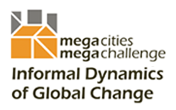Conference: Health in Megacities and Urban Areas
September 23-24, 2008
Room: R2-149
Chairs: Prof. Dr. Alexander Krämer and Dr. MMH Khan
Department of Public Health Medicine
School of Public Health, Bielefeld University
A growing number of megacities all over the world, particularly in developing countries, pose multidimensional challenges in many sectors including public health. Megacities are results of globalization processes and subject to global ecological, socio-economic, and political change. They are already overburdened by a number of vulnerable groups of people often neglected and victimized by the existing structures like political, institutional, social, and health systems. Vulnerable groups are mainly composed of people like marginal settlers, unskilled migrants, informal and daily labourers, floating populations, refugees and minorities. Their extreme poverty and limited income frequently force them to live in the stressful and hazardous conditions like slums. The slums are called the spatial manifestations of urban poverty, social exclusion and inappropriate government policies and are often characterized by one or more of shortcomings like poorly structured houses crowded together, insecurity of tenure, deficient access to safe drinking water and sanitation, stagnation of water and poor drainage with excessive open sewers, excessive amount of uncollected rubbish, severe overcrowding, flies, and poor lighting.
At present, about 1 billion people live in slum communities in the world and experts projected that the number will double by 2030, whereas the global population will increase from 6 to 8 billion by that period of time. Such populations have become a major reservoir for a wide spectrum of diseases. Poverty, low income, malnutrition with low resistance, poor housing, overcrowding, inadequate health knowledge, poor life-styles, and poor environmental management favor vector breeding and promote the spread of communicable diseases in poor communities. For instance, overcrowding makes poor residents vulnerable to tuberculosis and acute respiratory infections. Inadequate provision for drainage and sanitation raises the risk of diarrhoeal diseases and malaria. Among the vulnerable populations, a higher burden of diseases and public health problems is related to many factors such as socio-demographic characteristics, life-styles, economical activities, pollutions, climate, infrastructures, governability, livelihoods, and health sector properties. National and international interdisciplinary collaborations among scientists from numerous fields such as demography, economic geography, food and nutrition science, climatology, meteorology, urban planning, health statistics, epidemiology and public health are needed to overcome these problems.
Megacities are not only a source of concern but also a source of opportunities. Opportunities because the city provides new livelihood options for millions of new migrants with the possibility of an improvements in their living standards. Generally megacities are characterized by new scales, new dynamics and new complexities. These cities are considered as the engines of national economy, focal points of globalization and driving forces for developments. In these megacities a trained and highly specialized workforce can be distinguished from a cheap labor market, and accordingly a formal economic sector can be distinguished from an informal economic sector. It is without doubt that the informal economic sector is of great importance particularly in low and medium income developing countries for their economic growth.
Some of these issues of health in megacities will be highlighted in our forthcoming satellite conference. The first session will pose the crucial question “how to measure health in megacities?” Further sessions will focus on health and environmental factors, health and informal migrations, health and informal economical activities, health and water, health and urban livelihoods and health and food systems. These sessions will be followed by a general discussion between all participants with the aim for strengthened co-operations in health related aspects of megacity research.


